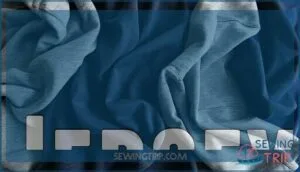This site is supported by our readers. We may earn a commission, at no cost to you, if you purchase through links.

You’ll get cotton’s softness and breathability paired with polyester’s durability and moisture-wicking properties.
Pure cotton feels amazing but shrinks and fades over time.
Straight polyester lasts forever but can feel synthetic against your skin.
Fleece offers maximum warmth but less versatility.
The 60/40 or 80/20 cotton-poly ratio strikes the perfect balance – your hoodie stays comfortable through countless washes while maintaining its shape and color.
Different fabric weights and weaving techniques can completely transform how your hoodie performs in various situations, making durability and moisture-wicking properties essential considerations.
Table Of Contents
Key Takeaways
- Cotton-polyester blends are your best bet – You’ll get cotton’s softness and breathability plus polyester’s durability and moisture-wicking in one fabric that won’t shrink or fade like pure cotton.
- Choose fabric based on your lifestyle – Pick fleece for maximum warmth, cotton for casual comfort, polyester for active wear, or blends for everyday versatility that handles multiple situations.
- Consider the 60/40 or 80/20 cotton-poly ratio – These blends strike the perfect balance between comfort and performance, keeping your hoodie looking good through countless washes.
- Factor in warmth, breathability, and durability – You’ll want to match your hoodie’s fabric to how you’ll use it most – whether that’s lounging at home, working out, or braving cold weather.
Best Fabric Materials for Hoodies
You’ll find four standout fabric options that consistently deliver the perfect balance of comfort, durability, and performance for hoodies.
Each material brings unique strengths to match your specific needs and lifestyle preferences.
Fleece
When you need warmth without bulk, fleece delivers exceptional fleece warmth through its unique structure of tiny air pockets.
This softest hoodie fabric offers unmatched fleece softness while maintaining impressive fleece breathability.
The synthetic fibers provide excellent fleece durability, resisting pilling and maintaining shape through countless washes.
Fleece hoodie fabric excels at moisture-wicking, keeping you dry during activities.
Among hoodie material types, fleece stands out as the best fabric warmth option.
While fleece sustainability varies by production method, recycled polyester fleece offers an eco-friendly alternative that transforms plastic bottles into cozy comfort.
For a lighter feel, consider a hoodie with a lower fabric weight.
Cotton
Cotton delivers unmatched comfort through its natural cotton softness and breathability.
This cotton hoodie fabric absorbs moisture effectively while regulating temperature during casual wear. 100 cotton offers maximum comfort but requires careful washing to prevent shrinkage.
Organic cotton provides eco-friendly softness without harsh chemicals. Cotton blends with polyester create more durable options, while cotton weight determines warmth levels.
You can find a wide variety here. Cotton absorbency makes it ideal for everyday wear, though cotton-poly blend versions resist wrinkles better than pure cotton varieties, offering a wide variety of choices.
Polyester
When you’re looking for a performance-focused hoodie, synthetic fibers like polyester deliver unmatched durability and function.
This athletic hoodie material excels at moisture-wicking while maintaining its shape through countless washes.
- Superior moisture management – Polyester hoodie fabric actively pulls sweat away from your skin
- Enhanced polyester durability – Synthetic fibers resist shrinking, fading, and pilling
- Quick-drying performance – Microfiber polyester construction speeds up drying time
- Eco-friendly options – Recycled polyester reduces environmental impact without sacrificing quality
Polyester properties make it ideal for active lifestyles, though polyester blends often provide better breathability than pure synthetic options, as they can offer essential breathable properties.
Polyester-Cotton (Polycotton) Blends
Polycotton blends combine polyester’s durability with cotton’s breathability, creating versatile hoodies perfect for daily wear.
These cottonpoly blend fabrics offer wrinkle resistance and cost efficiency while maintaining comfort factors like moisture absorption. Popular blend ratios include 50/50 or 60/40 cotton-to-polyester combinations.
You’ll find these hoodie fabric blends balance polyester hoodie fabric’s quick-drying properties with cotton’s softness. Shoppers can find a variety of options online.
However, environmental impact remains a concern due to polyester production. These hoodies deliver reliable performance for most lifestyles, offering a great combination of durability and breathability, with the added benefit of moisture absorption and wrinkle resistance.
Factors to Consider When Choosing Hoodie Fabric
When choosing hoodie fabric, you’ll need to balance three key factors: warmth, breathability, and durability. Each factor affects how comfortable and long-lasting your hoodie will be in different situations.
Warmth
When temperatures drop, warmth becomes your hoodie’s most important job.
Your hoodie should feel like armor against the cold.
Fleece excels at thermal retention through air pockets that trap body heat, while fabric weight determines insulation properties for different climate suitability needs.
- Cozy fleece that hugs you like a warm embrace on chilly mornings
- Thick insulation that shields you from biting winter winds
- Layering options that adapt as temperatures shift throughout your day
- Heavyweight materials that cocoon you during outdoor adventures
- Thermal retention that keeps your core temperature steady during any activity level
Breathability
Breathable hoodie fabric prevents that sticky, uncomfortable feeling when you’re active.
Natural fibers excel at air permeability – cotton’s fiber structure allows excellent air flow while providing superior moisture absorption.
Polyester blends offer moisture-wicking properties that pull sweat away from your skin.
Weave density affects breathability too – looser weaves increase air circulation but may reduce warmth.
Temperature regulation becomes easier when your hoodie fabric works with your body’s cooling system.
Look for fabrics that balance hoodie fabric breathability with insulation needs for maximum comfort, and provide a natural fit with air permeability.
Durability
Fabric durability determines how well your hoodie withstands daily wear and washing cycles.
Strong materials resist common problems that shorten garment life.
- Pilling Resistance – Quality fabrics maintain smooth surfaces without fiber balls forming
- Fade Resistance – Durable hoodie fabric retains original colors through multiple washes
- Tear Strength – Robust materials resist rips and snags during active use
- Seam Strength – Well-constructed seams prevent splitting at stress points
Choose durable hoodie fabric with proven wash durability for long-lasting wear.
Synthetic options like hoodies made of polyester offer durability.
How to Choose The Right Fabric for Your Hoodie
Selecting the perfect hoodie fabric depends on three key factors that match your specific needs.
Consider your flexibility requirements, lifestyle demands, and aesthetic preferences to find the ideal material for your hoodie.
Flexibility
Movement matters when you’re choosing hoodie fabric.
Your activity type determines whether you need 2way stretch for basic motion or 4way stretch for athletic activities.
Stretchy fabric blends offer the best range motion and comfort level.
French terry and jersey provide excellent fabric stretch, while bamboo and double knit blend options deliver flexibility without compromising durability for unrestricted movement.
Lifestyle
Your lifestyle shapes which hoodie fabric fits best.
Choose fabric that matches how you live, not just how you look.
Match your daily routine to fabric performance for maximum comfort and satisfaction.
Consider these lifestyle factors when choosing hoodie fabric:
- Active Lifestyle – Select moisture-wicking polyester or fleece blends that handle sweat and movement during workouts, hiking, or sports activities
- Casual Wear – Choose soft cotton or cotton blends for lounging, errands, and relaxed social settings where breathability matters most
- Professional Settings – Pick refined fabrics like merino wool blends or premium cotton that maintain shape and appearance throughout long days
Your comfort needs vary by season and activity level.
Cotton works well for mild weather and low-intensity days.
Fleece suits cooler climates and outdoor adventures.
Climate adaptability becomes vital when you travel frequently or live in changing weather patterns.
Fashion preferences also influence fabric choice.
Some fabrics drape better, hold color longer, or resist pilling.
Match your hoodie’s fabric to how you’ll wear it most often.
Aesthetics
Beyond simple comfort, your hoodie’s fabric choice dramatically impacts its visual appeal.
Fabric drape determines how your hoodie falls and moves with your body, while color vibrancy affects how designs pop.
| Aesthetic Factor | Impact on Design |
|---|---|
| Fabric texture | Creates visual interest and tactile appeal |
| Surface finish | Affects print quality and overall look |
| Color retention | Maintains vibrancy after washing |
| Fabric aesthetics | Influences drape and silhouette |
Consider how fabric design elements work together—smooth cotton showcases crisp prints, while textured fleece adds depth to solid colors.
Choosing the right fabric also means considering breathability and comfort for the wearer.
Common Fabrics Used for Hoodies
While fleece, cotton, and polyester dominate the hoodie market, you’ll also find jersey and wool options that bring their own advantages to the table.
Jersey offers exceptional stretch and drape for a more fitted look, while wool provides natural temperature regulation and odor resistance that synthetic fabrics can’t match.
Jersey
Jersey fabric offers exceptional stretch and comfort that makes it perfect for active lifestyles.
You’ll appreciate how jersey knit moves with your body, providing freedom during workouts or daily activities.
This versatile material works great for both casual wear and activewear use.
- Superior Stretch: Cotton jersey and jersey blends conform to your movements without restricting mobility
- Breathability Benefits: The knit structure promotes air circulation, keeping you comfortable during physical activities
- Durability Factor: Double knit varieties offer enhanced structure and longevity compared to single jersey options
- Shape Retention: Jersey drape creates a flattering silhouette while maintaining its form after repeated wear
Cotton jersey stands out for its softness against skin, while polyester blends add moisture-wicking properties.
For ideal use, consider how fabric weight impacts warmth.
The fabric’s breathability makes it suitable for layering or standalone wear.
Whether you choose single or double knit construction, jersey delivers consistent comfort and performance for your hoodie needs.
Wool
Wool transforms your hoodie into a natural climate control system, delivering exceptional warmth and breathability.
Merino wool offers superior softness while maintaining wool durability that outperforms cotton by thousands of bends.
Though wool cost runs higher than alternatives, wool blends provide budget-friendly options without sacrificing insulation.
This hoodie fabric excels in moisture management, absorbing 30% of its weight without feeling damp.
Wool alternatives like synthetic fleece can’t match wool’s natural temperature regulation and odor resistance.
| Property | Wool Performance |
|---|---|
| Insulation | Excellent even when wet |
| Breathability | Natural moisture-wicking |
| Durability | 20,000 bends vs 3,000 cotton |
| Maintenance | Requires gentle care |
| Cost | Premium pricing |
Where to Manufacture Your Hoodies
Once you’ve chosen your perfect hoodie fabric, you’ll need to find the right manufacturing partner. Your options fall into two main camps: local sourcing and overseas factories.
Local sourcing offers shorter lead times and easier quality control visits, but you’ll pay premium prices. Overseas factories in China, Bangladesh, and Vietnam provide cost advantages – China leads with 500 million hoodies annually, while Bangladesh offers competitive pricing for major brands.
Key considerations include minimums and lead times. Most factories require 100-piece minimum orders per design. Ethical production matters too – verify your manufacturer follows fair labor practices and environmental standards.
Your supply chain strategy affects everything from fabric sourcing to garment production timelines. Research manufacturers thoroughly, request samples, and establish clear quality control protocols. Whether you choose domestic or international partners, prioritize transparency in your manufacturing relationship for consistent results.
Frequently Asked Questions (FAQs)
What is the highest quality fabric for hoodies?
Merino wool stands out as the highest quality hoodie fabric. You’ll get exceptional temperature regulation, natural odor resistance, and moisture-wicking properties that synthetic materials can’t match.
Should hoodies be 100% cotton?
Surprisingly, 100% cotton hoodies aren’t always your best choice. While cotton offers breathability and comfort, blends like cotton-polyester provide better durability, moisture-wicking, and shape retention for active lifestyles.
Is fleece or cotton better for hoodies?
Cotton’s better for breathability and comfort, while fleece excels in warmth and moisture-wicking. You’ll want cotton for casual wear, fleece for cold weather or active use.
What material makes the softest hoodie?
Premium fabrics transform your comfort experience dramatically.
French terry’s plush interior creates cloud-like softness, while organic cotton delivers natural gentleness against skin.
For ultimate luxury, merino wool blends offer silky smoothness that’ll make you never want to take it off.
How do I wash different hoodie fabrics?
Wash cotton hoodies in cold water with gentle detergent.
Use delicate cycle for fleece to prevent pilling.
Air-dry wool blends to avoid shrinkage.
Polyester handles warm water and machine drying well.
Which fabrics shrink the most after washing?
Like a washing machine’s relentless spin cycle, natural fibers surrender most to shrinkage.
You’ll find 100% cotton shrinks dramatically, while wool contracts substantially.
Cotton-poly blends resist better, and synthetic fabrics like polyester stay put.
Whats the best fabric for sensitive skin?
For sensitive skin, you’ll want organic cotton or bamboo fabric hoodies. These natural materials are hypoallergenic, pesticide-free, and gentler against your skin than synthetic blends or treated fabrics.
How do fabric weights affect hoodie appearance?
Heavier fabric weights create a more structured, less drapey silhouette that hangs closer to your body.
Lighter weights flow freely, giving you a relaxed, casual look with better movement and breathability.
Which hoodie fabrics resist stains and odors?
Polyester and polyester blends won’t absorb odors like cotton does. They’re naturally stain-resistant and wick moisture away, keeping you fresher longer than pure cotton hoodies.
Conclusion
Choosing what’s the best fabric for hoodies doesn’t have to overwhelm you.
Cotton-polyester blends deliver the winning combination you need. You’ll enjoy cotton’s natural comfort with polyester’s long-lasting performance.
Pure materials have their place, but blends offer versatility for daily wear. Consider your climate, activity level, and washing preferences when making your choice.
The right fabric transforms your hoodie from basic clothing into your go-to comfort piece that withstands countless adventures.
- https://modaknits.com/is-100-cotton-the-best-for-hoodies/
- https://vocal.media/lifehack/how-to-choose-the-best-material-for-hoodies-a-complete-hoodie-fabric-guide
- https://www.billoomifashion.com/post/which-fabric-should-i-choose-for-hoodies-sweatshirts-collection-ultimate-guide
- https://www.longancraft.com/blogs/fabric-knowledge/choose-the-best-fabric-for-hoodies
- https://en.wikipedia.org/wiki/Hoodie











